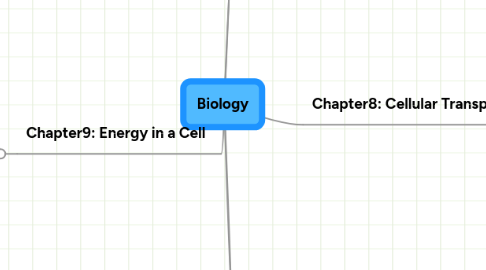
1. Chapter11: DNA and Genes
1.1. DNA: The Molecule of Herediy
1.1.1. What is DNA?
1.1.1.1. DNA as Genetic Material
1.1.1.2. The Structure of Nucleode
1.1.1.3. The Structure of DNA
1.1.1.4. The Importance of Nucleotide Sequence
1.1.2. Replication of DNA
1.1.2.1. How DNA Replicates
1.2. From DNA to Protein
1.2.1. Genes and Protein
1.2.2. RNA
1.2.3. Transcription
1.2.4. RNA Processing
1.2.5. The Genetic Code
1.2.6. Translation: From mRNA to Protein
1.2.6.1. The Role of TransferRNA
1.2.6.2. Translating the mRNA code
1.3. Genetic Changes
1.3.1. Mutation
1.3.1.1. Mutations in reproductive Cells
1.3.1.2. Mutations in Body Cells
1.3.1.3. The Effect of Point Mutations
1.3.1.4. Frameshift Mutations
1.3.2. Chromosomal Mutation
1.3.3. Causes of Mutation
1.3.3.1. Repairing DNA
2. Chapter9: Energy in a Cell
2.1. The Need for Energy
2.1.1. Cell Energy
2.1.1.1. Work and the need for energy
2.1.2. Forming and Breaking Down ATP
2.1.2.1. How cells tap into the energy stored in ATP
2.1.3. The Uses of Cell Energy
2.2. Photosynthesis: Trapping the Sun's Energy
2.2.1. Trapping Energy from Sunlight
2.2.1.1. The chloroplasts and pigments
2.2.2. Light Dependant Reactions
2.2.2.1. Restoring Electrons
2.2.3. Light Independent Reactions
2.2.3.1. The Calvin Cycle
2.3. Getting Energy to make ATP
2.3.1. Cellular Respiration
2.3.1.1. Glycolysis
2.3.1.2. The Citric Acid Cycle
2.3.1.3. The electron transport chain
2.3.2. Fermentation
2.3.2.1. Lactic acid fermentation
2.3.2.2. Alcoholic Fermentation
2.3.3. Comparing Photosynthesis and Cellular Respiration
3. Chapter7 :A view of the Cell
3.1. The Discovery of Cells
3.1.1. The History of the Cell Theory
3.1.1.1. Light Microscopes
3.1.1.2. The Cell Theory
3.1.1.3. Electron Microscopes
3.1.2. Two Basic Cell Types
3.2. The Plasma Membrane
3.2.1. Maintaining a Balance
3.2.1.1. Why Cells must control material
3.2.2. The Structure of the Plasma Membrane
3.2.2.1. The phospholipid bilayer
3.2.2.2. Other Components of the Plasma Membrane
3.3. Eukaryotic Cell Structure
3.3.1. Cellular Boundries
3.3.1.1. The Cell Wall
3.3.2. The Nucleus and Cell Control
3.3.3. Assembly, Transport and Storage
3.3.3.1. Organelles for assembly and transport of proteins
3.3.3.2. Vacuoles and storage
3.3.3.3. Lysomes and recycling
3.3.4. Energy Transformers
3.3.4.1. Chloroplasts and energy
3.3.4.2. Mitochondria and energy
3.3.5. Organelles for Support and Locomotion
3.3.5.1. The Cytoskeleton
3.3.5.2. Centrioles
3.3.5.3. Cilia and Flagella
4. Chapter12:Patterns of Heredity and Human Genetics
4.1. Mendelian Inheritance of Human Traits
4.1.1. Making a Pedigree
4.1.1.1. Pedigrees Illustrate inheritance
4.1.1.2. Analyzing a pedigree
4.1.2. Simply Dominant Heredity
4.1.2.1. Simple dominant traits
4.1.2.2. Huntington's disease
4.1.3. Simple Recessive Heredity
4.1.3.1. Cystic Fibrosis
4.1.3.2. Tay-Sachs disease
4.1.3.3. Phenylketouria
4.2. When Heredity follows Different Rules
4.3. Complex Inheritance of Human Traits
5. Chapter8: Cellular Transport and the Cell Cycle
5.1. Cellular Transport
5.1.1. Osmosis: Diffusion of Water
5.1.1.1. What controls osmosis?
5.1.1.2. Cells in an isotonic solution
5.1.1.3. Cells in a Hypertonic Solution
5.1.1.4. Cells in a hypotonic solution
5.1.2. Passive Transport
5.1.2.1. Passive transport by proteins
5.1.3. Active Transport
5.1.3.1. How active transport occurs
5.1.4. Transport of large particles
5.2. Cell Growth and Reproduction
5.2.1. Cell size Limitations
5.2.1.1. Diffusion limits cell size
5.2.1.2. DNA limits cell size
5.2.1.3. Surface area to volume ratio
5.2.2. Cell Reproduction
5.2.2.1. The discovery of chromosomes
5.2.2.2. The structure of eukaryotic chromosomes
5.2.3. The Cell Cycle
5.2.3.1. Chromosome Structure
5.2.4. Interphase: a busy phase
5.2.5. The Phases of Mitosis
5.2.5.1. Prophase: The first phase
5.2.5.2. Metaphase: The second phase
5.2.5.3. Anaphase: The third phase
5.2.5.4. Telophase: The fourth phase
5.2.6. Cytokinesis
5.2.7. Results of Mitosis
5.3. Control of the Cell Cycle
5.3.1. Normal Control of the Cell Cycle
5.3.1.1. Proteins and enzymes control the Cell Cycle
5.3.2. Cancer: a mistake in the cell cycle
5.3.2.1. The causes of cancer
5.3.2.2. cancer prevention
6. Chapter10: Mendel Meiosis
6.1. Mendel's Law of Heredity
6.1.1. Why Mendel Succeeded
6.1.1.1. Mendel chose his subject carefully
6.1.1.2. Mendel was a careful researcher
6.1.2. Mendel's Monohybrid Crosses
6.1.2.1. The First Generation
6.1.2.2. The Second Generation
6.1.2.3. The rule of unit factors
6.1.2.4. The rule of dominace
6.1.2.5. The law of segregation
6.1.3. Mendel's Dihybrid Crosses
6.1.3.1. The first generation
6.1.3.2. The second generation
6.1.3.3. The law of independent assortment
6.1.4. Punnett Squares
6.1.4.1. Monohybrid crosses
6.1.4.2. Dihybrid Crosses
6.1.5. Phenotypes and Genotypes
6.1.6. Probability
6.2. Meiosis
6.2.1. Genes, Chromosomes, and Numbers
6.2.1.1. Diploid and Haploid cells
6.2.1.2. Homologous Chromosomes
6.2.1.3. Why Meiosis?
6.2.2. Meiosis Provides for Genetic Variation
6.2.2.1. Genetic recombination
6.2.2.2. Meiosis explains Mendel's results
6.2.3. Nondisjuction
6.2.3.1. Chromosome Mapping
6.2.3.2. Polyploidy
6.2.4. Gene Linkage and Maps
6.2.5. The Phases of Meiosis
6.2.5.1. Interphase
6.2.5.2. Prophase I
6.2.5.3. Metaphase I
6.2.5.4. Anaphase I
6.2.5.5. Telophase I
6.2.5.6. The phases of meiosis II
